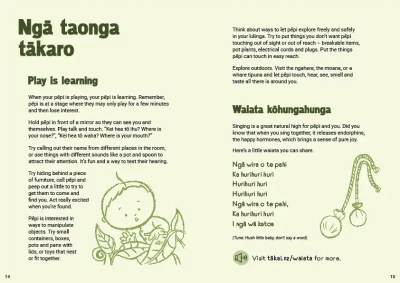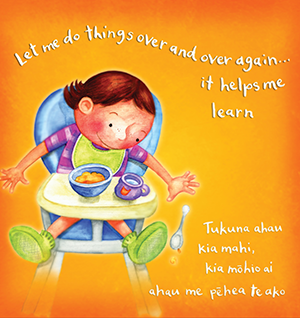
Helping baby to move around
Babies become mobile at different ages and progress through different stages of movement, here are some ideas for encouraging movement and making the floor safe for baby.
Babies become mobile at different ages. Sometimes it depends on their genes and sometimes it depends on how much opportunity they get to practise.
Ask whānau:
- What have you noticed baby doing that’s new?
- What sort of moving is baby doing?
How babies move
The way a baby moves will vary. They usually start with rolling before moving to some form of crawling. This might be commando crawling, crawling using hands and feet, or rocking on all fours before using alternating hands and knees in a ‘cross crawl’.
Some babies won’t crawl and will prefer to ‘bottom shuffle’. Babies who suffer from reflux and find being on their tummies uncomfortable will often choose this way of moving.
Pulling up and cruising
Often, once they’ve mastered some form of crawling or shuffling, they’ll be looking for a stable object to pull themselves up into a standing position.
Usually it will be furniture, which they’ll then ‘cruise’ along – holding on to it before walking across gaps between furniture and finally moving to walking independently.
Ideas to encourage baby’s movement
If a baby isn’t moving at all, ask whānau:
- Do you think they’re feeling frustrated by not being more mobile?
- How do they react to tummy time? Not well?
- Have you tried letting them lie with their chest up on a cushion?
A tri- (three-cornered) pillow can work well for babies with reflux, as it keeps the pressure off their puku. Parents have to stay close by though, in case they roll off.
If baby doesn’t enjoy tummy time, maybe a parent could lie down on their back, put their head on a pillow and let baby lie on the parent’s chest and tummy.
Baby will want to lift their head to look at the parent’s face, which can be much more exciting than staring at the floor.
- What could we do to encourage baby to move more?
- What happens when there’s something baby wants that’s just out of reach?
Put an interesting toy in front of baby and encourage them to move to it. Making it into a game and repeating it a few times a day may be all the practice baby needs.
Safety for babies on the move
Remind the whānau that once baby is mobile, it’s a good idea to get down on the floor and look for all the things that might be dangerous to a crawling baby.
In Whakatipu Te Pihinga 2 (page 15) gives some ideas about making it safe for baby to explore.
Here’s an example of how you might encourage whānau to make their home safe for baby:
- Let’s check this room together. Where are the potential dangers to baby? Point out cords, dangling things, electric sockets stairs, plants, small items.
We’ll make a list in the back of your Whakatipu booklet of the things that might need some attention. You might want to look in other rooms of the house that baby could get into and make them safe too.
Other places for tummy time
Some whānau may not want their baby to be moving around on the floor of their home. If so, talk about other places that might be safe for baby to practise their motor skills.
- Where are the local baby play spaces in the community?
- Would the local library be suitable?
- What about playgroups nearby?
Try an activity
Getting out and about with baby
Go for an adventure, teach your baby about the world outside the home.
Helpful resources for whānau
-
Active movement activity guides
Sport New Zealand
Sport New Zealand - Ihi Aotearoa introduction to active movement for under-fives.













